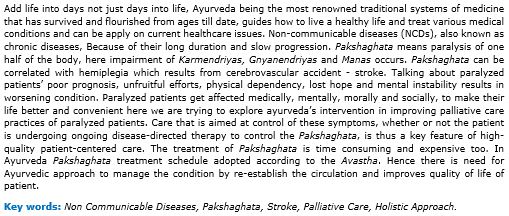A review on Palliative Care in Pakshaghata
Keywords:
Non Communicable Diseases, Pakshaghata, Stroke, Palliative Care, Holistic Approach.Abstract
Add life into days not just days into life, Ayurveda being the most renowned traditional systems of medicine that has survived and flourished from ages till date, guides how to live a healthy life and treat various medical conditions and can be apply on current healthcare issues. Non-communicable diseases (NCDs), also known as chronic diseases, Because of their long duration and slow progression. Pakshaghata means paralysis of one half of the body, here impairment of Karmendriyas, Gnyanendriyas and Manas occurs. Pakshaghata can be correlated with hemiplegia which results from cerebrovascular accident - stroke. Talking about paralyzed patients’ poor prognosis, unfruitful efforts, physical dependency, lost hope and mental instability results in worsening condition. Paralyzed patients get affected medically, mentally, morally and socially, to make their life better and convenient here we are trying to explore ayurveda’s intervention in improving palliative care practices of paralyzed patients. Care that is aimed at control of these symptoms, whether or not the patient is undergoing ongoing disease-directed therapy to control the Pakshaghata, is thus a key feature of high-quality patient-centered care. The treatment of Pakshaghata is time consuming and expensive too. In Ayurveda Pakshaghata treatment schedule adopted according to the Avastha. Hence there is need for Ayurvedic approach to manage the condition by re-establish the circulation and improves quality of life of patient.
Downloads
References
World health organization; palliative care; 2021 [cited 2022 march 15] Available from:https://www.who.int/news-room/fact-sheets/detail/palliative-care
Dr. MR. Rajgopal, director, WHO collaborating centre for policy and training on access to pain relief and founder- chairman, pallium -The current status of palliative care in India. [cited 2022 march 15] Available from-https://www.theatlantic.com/health/archive/2017/02/india-palliative-care/517995/
Global Health Estimates. Geneva: World Health Organization; 2012. [cited 2022 april 24] Available from: http://www.who.int/healthinfo/global_burden
Charak Samhita of Agnivesa; by Acharya Vidyadhar Shukla and R. Tripathi; Chaukhamba Sanskrit Pratishthan; reprint 2017; Chikitsa Sthana 28/55; Pg No 697.
Dr.Nimmi M. Menon, Dr. Manjunath Adiga, Ayurvedic management of Pakshaghata with special reference to hemiplegia in terms of CVA of thrombotic origin- A single case report, wjpls,2022, vol 8, Issue 8, 187-198.
Dr. Bramhanand Tripathi, Ashtang hridayam of Shrimad Vagbhata, Choukhamba Sanskrit Pratisthan; Reprint 2015, Nidan Sthana 15/38-39; Pg No 542.
Acharya Vidyadhar Shukla and R. Tripathi, Charak Samhita of Agnivesa, Chaukhamba Sanskrit Pratishthan, reprint 2017, Chikitsa Sthana 28/15-18; Pg No 690.
Dr. Anant Ram Sharma, Sushrut Samhita of Maharshi Sushruta, Choukhamba Surbharati Prakashan; reprint 2015, volume I, Nidan Sthana 1/60-62, Pg No 465.
Acharya Vidyadhar Shukla and R. Tripathi, Charak Samhita of Agnivesa, Chaukhamba Sanskrit Pratishthan, reprint 2017, Chikitsa Sthana 28/19-18, Pg No 690.
Acharya Vidyadhar Shukla and R. Tripathi, Charak Samhita of Agnivesa, Chaukhamba Sanskrit Pratishthan, reprint 2017, Chikitsa Sthana 28/53-55, Pg No 697.
Dr. Anant Ram Sharma, Sushrut Samhita of Maharshi Sushruta, Choukhamba Surbharati Prakasha, reprint 2015, volume 1, Nidan Sthana 1/62, Pg No 465.
Dr. Bramhanand Tripathi, Ashtang Hridayam of Shrimad Vagbhata, Choukhamba Sanskrit Pratisthan, Reprint 2015, Nidan Sthana 15/38, Pg No 542.
Acharya Vidyadhar Shukla and R. Tripathi, Charak Samhita of Agnivesa, Chaukhamba Sanskrit Pratishthan, reprint 2017, Chikitsa Sthana 28/53-55,Pg No 697.
Dr. Anant Ram Sharma. Sushrut Samhita of maharshi sushruta, choukhamba surbharati prakashan, reprint 2015, volume 1, nidan sthana 1/60-62, Pg No 465.
Dr. Bramhanand Tripathi, Ashtang Hridayam of Shrimad Vagbhata, Choukhamba Sanskrit pratisthan, Reprint 2015, Nidan Sthana 15/38, Pg No 542.
Vd.Y.G.Joshi, Textbook of Kayachikitsa, PSV Publications, Reprint 2016, Vatavyadhi chapter, Pg No 259.
Acharya Vidyadhar Shukla and R. Tripathi, Charak Samhita of Agnivesa, Chaukhamba Sanskrit Pratishthan, reprint 2017, Chikitsa Sthana 28/235,Pg No 722.
Dr. Anant Ram Sharma, Sushrut Samhita of Maharshi Sushruta, Choukhamba Surbharati Prakashan, reprint 2015, volume 1, Nidan Sthana 1/63, Pg No 466.
Dr. Bramhanand Tripathi, Ashtang Hridayam of Shrimad Vagbhata, Choukhamba Sanskrit Pratisthan, Reprint 2015, Nidan Sthana 15/41, Pg No 542.
Bramashankar S, Madhav Nidan, Madhukosha Vyakhya, Chaukhambha Publication, Varanasi, reprint 2012, volume 1, Vatavyadhi Nidan, Sloka no. 43, Pg No. 163.
Acharya Vidyadhar Shukla and R. Tripathi, Charak Samhita of Agnivesa, Chaukhamba Sanskrit Pratishthan, reprint 2017, Chikitsa Sthana 28/75-77, Pg No 70.
Dr. Bramhanand Tripathi, Ashtang Hridayam of Shrimad Vagbhata, Choukhamba Sanskrit Pratisthan, Reprint 2015, Chikitsa Sthana 21/1-3, Pg No 803.
Dr. Anant Ram Sharma, Sushrut Samhita of Maharshi Sushruta, Choukhamba Surbharati Prakashan, reprint 2015, volume 1, Chikitsa Sthana 4/19, Pg No 218.
Acharya Vidyadhar Shukla and R. Tripathi, Charak Samhita of Agnivesa, Chaukhamba Sanskrit pratishthan, reprint 2017, Chikitsa Sthana 28/83,Pg No 702.
Acharya Vidyadhar Shukla and R. Tripathi, Charak Samhita of Agnivesa, Chaukhamba Sanskrit pratishthan, reprint 2017, Chikitsa Sthana 28/100, Pg No 75.
Dr. Bramhanand Tripathi, Ashtang hridayam of Shrimad Vagbhata, Choukhamba Sanskrit Pratisthan, Reprint 2015, chikitsa sthana 21/44,Pg No 809.
Acharya Vidyadhar Shukla and R. Tripathi, Charak Samhita of Agnivesa, Chaukhamba Sanskrit pratishthan, reprint 2017, Chikitsa Sthana 28/86, Pg No 703.
Vd.Y.G.Joshi, Textbook of Kayachikitsa, PSV Publications, Reprint 2016, Vatavyadhi chapter, Pg No 260.
Dr. Anant ram sharma, Sushrut Samhita of Maharshi Sushruta, Choukhamba Surbharati Prakashan, reprint 2015, volume 1, Chikitsa Sthana 4/13, Pg No 206.















